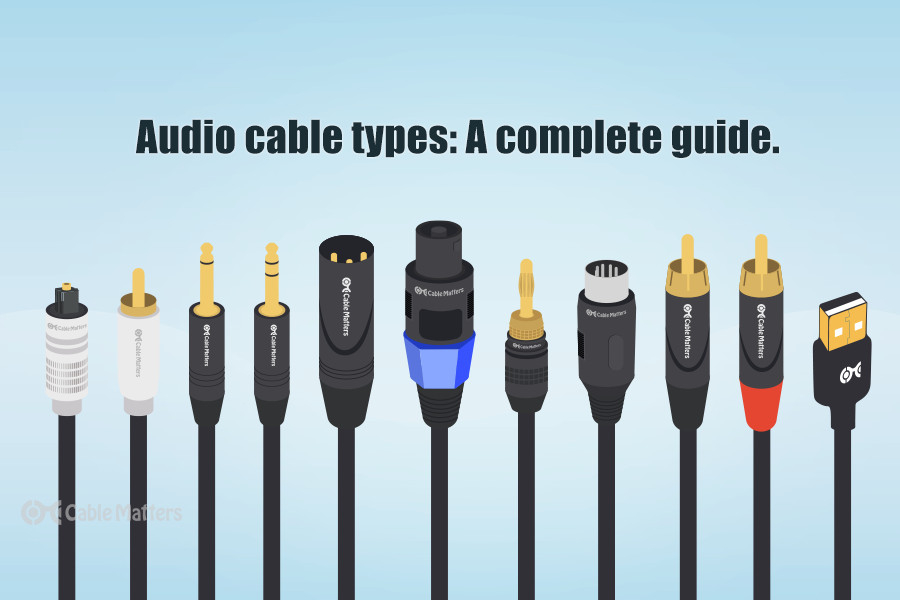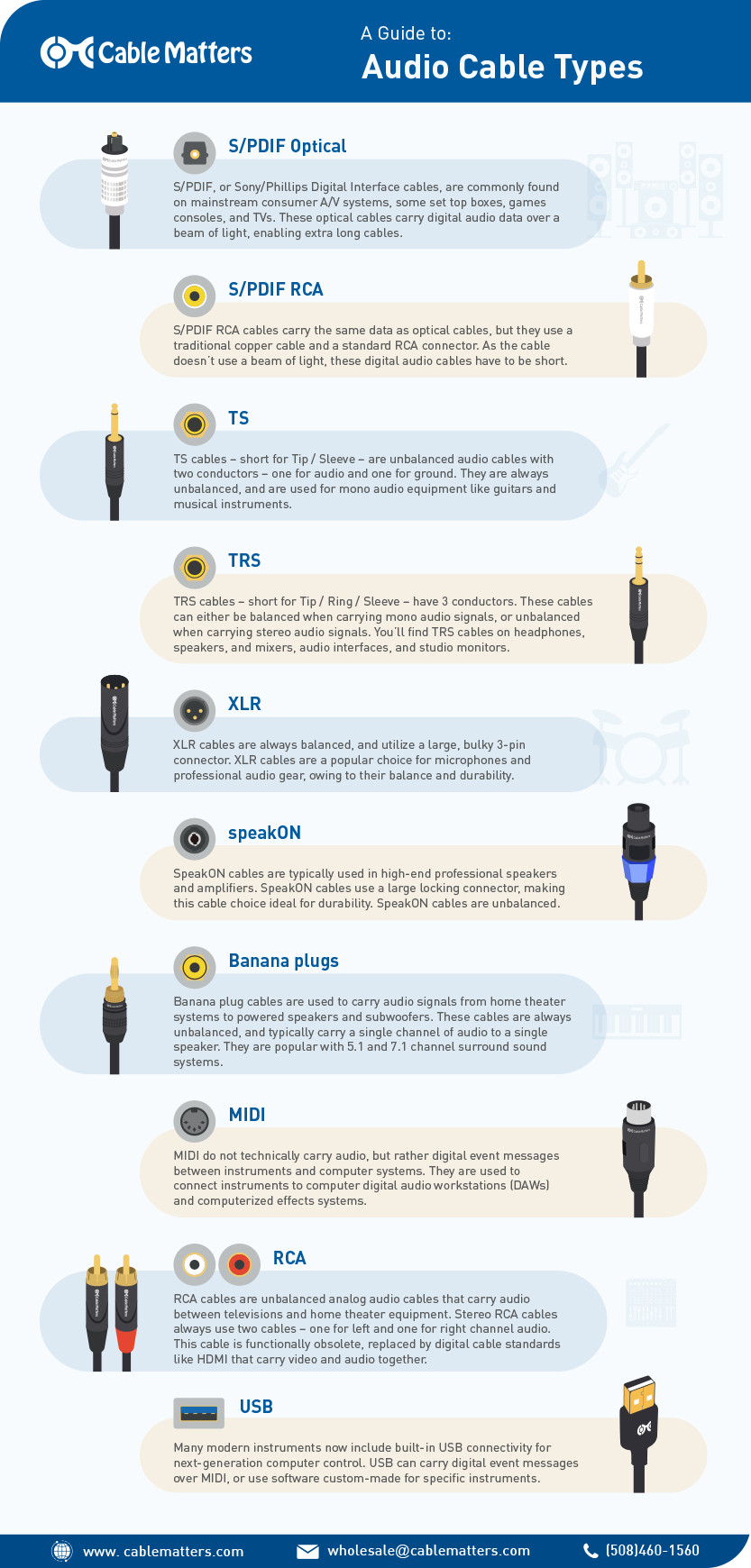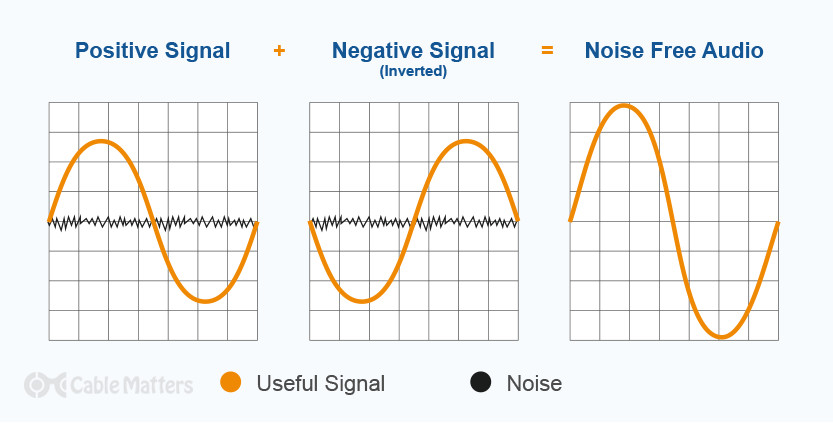

Click the photo to open the full infographic.
Audio cable types are some of the most numerous of any cable, with both the consumer and professional space packed with different options for different uses and different generations of technology. That can make it difficult to know which is the best audio cable type for your new setup, whether it’s purely for listening, for live performances, or for professional and hobby mixing. Some devices only support digital or analog cables, others are legacy devices which need access to older audio cable types, and you need to consider cable length too; not to mention shielding and balancing.
The wide array of different cables for audio production and enjoyment doesn’t need to be opaque and intimidating, though. Here’s a comprehensive guide to the various audio cable types available and why you might want to choose some over others.
Balanced vs. Unbalanced cables
Before we dive into the individual types of audio cables you can pick from and what they do, there’s an important terminology that needs explaining: balance. Some audio cable types are considered balanced, while others are unbalanced, and it’s important to know whether balance will affect the eventual audio you hear, or not, as some situations require it, while others can do without.
A balanced cable is designed specifically to avoid external electrical interference by using an additional conductor wire inside the cable. Balanced cables feature a pair of conductor wires and a ground, whereas an unbalanced cable will feature just a single conductor wire and a ground. The two conductor wires in a balanced cable work together to cancel out any external electrical noise which could interfere with or affect the signal, in turn affecting the audio data the cable transmits.
Most mainstream cables aimed at home users are unbalanced, as the utmost audio clarity isn’t necessarily as important as a professional setting. Cables designed for audio creation or professional tasks, however, are almost always balanced to prevent signal degradation – though there are still some specific cases where that isn’t the case.

For an audio system to be balanced, however, it’s not just the audio cable types which need to be balanced: the equipment needs to be balanced too. Any devices connected with balanced cables also need to be balanced themselves in order to avoid the signal losing that protection at the point it reaches that device.
Unless you are building the world’s most balanced professional audio setup, however, you can typically get away with some unbalanced devices or cables, as long as you keep the cable runs short. Shorter cables have less potential for external interference, so can mitigate any problems that can arise with unbalanced cables. The ideal scenario for unbalanced cables is keeping them shorter than six feet.
Now that you understand the difference between balanced and unbalanced cables, let’s dive into cable types.
Audio Cable Types

TS Cables
TS Cables – short for Tip / Sleeve and often referred to as guitar cables or instrument cables – are one audio cable type that you want to keep as short as possible because they are always unbalanced. They allow you to connect mono (one-channel) audio sources like guitars, other unbalanced instruments, effects pedals, and drum machines to amplifiers, mixers, and audio interfaces.
Although they have the same physical dimensions as other audio cable types, like TRS, you can usually tell a TS cable from its contemporaries by its singular black band in the middle of the metal connector. TRS cables, in comparison, tend to have two black rings on the metal connector
TS cords are mostly available in 1/4-inch sizes, though you’ll also find the 1/8-inch (3.5mm) TS cable used in consumer products like mono headset microphones. The 1/4-inch TS cables feature better shielding and are the better option if given the choice to avoid signal noise.

TRS Cables
Although TRS cables look quite similar to the TS audio cable type, you’ll be able to spot the difference because it has two rubber strips on the connector header, which form 3 conductors: Tip / Ring / Sleeve. However, whereas the singular ring is a clear indicator of an (unbalanced) TS cable, just spotting the two rings on a TRS cable doesn’t tell you much, as they can be balanced or unbalanced depending on their use.
TRS cables can be balanced with a positive, negative, and ground conductor when used on mono equipment. TRS cables can also carry 2-channel stereo audio, making them unbalanced because the left and right audio channels take up two of the conductors.
TRS cables are most commonly used in headphones and headphone outputs on certain instruments, mixers, audio interfaces, and studio monitors. There are also TRRS cables – Tip / Ring / Ring / Sleeve – which have three black rings. They’re used in the same kind of instances, but with that additional ring, there is space for both left and right-channel audio, and microphone audio on a single audio cable type. This can be useful if a device has a built-in microphone and you want the audio from that to be separate from the other channels.
With both TRS and TS cables, there are plenty of methods of converting between the connector types and others – from TRS to TS cables to 3.5mm to 1/4 adapters.

XLR Cables
One of the most iconic and durable audio cable types, XLR cables are big and bulky, and as you might expect from such a sturdy cable, XLR cables are always balanced. That means that you can run really long XLR cables without fearing signal interference in the same way you would with a TS cable, for example.
XLR cables are one audio cable type that have really stood the test of time. Initially developed in the 1950s as a variant of the classic Type O connector, with the addition of a locking mechanism, and rubber insulation around the three contacts, we reached the XLR design that is still in use today.
Thanks to their lengthy history, XLR cables are found on all sorts of devices, from the very old to the very new, but they are particularly common with microphones, speakers, PA systems, DMX lights, and certain instruments. XLR cables are a great way to connect these sorts of devices to mixers and stage speakers to guarantee a clear and crisp signal, whether you’re running a short six foot cable, or a longer one that extends 50 feet.
Not all XLR cables are created equal. Cable Matters’ own XLR cables are designed for professional use, with strain relief on the connector, gold plated XLR pins for increased durability over long time use, and individual insulation and foil shielding for the internal wires, to further improve noise protection for the signal. You’ll also find plenty of XLR converter cables for XLR to 3.5mm, XLR to TRS, and XLR to RCA cables.
You can get away with cheaper XLR cables without the additional protections, especially if you’re just doing some hobby audio editing at home, but if you consider yourself any kind of audiophile, you will notice the difference. If you’re mixing audio professionally, too, it’s worth investing in quality cables to make sure that you don’t deliver an inferior product.

SpeakOn Cables
SpeakOn cables don’t see any use in the consumer device space and are considered by most to be the industry standard for connecting together professional speakers and amplifiers. Although they are typically unbalanced, they are still a popular alternative to 1/4-inch speaker cables thanks to their ability to lock in place to avoid accidental disconnection during live performances. They’re also rated to handle a higher level of electrical currents than other audio cable types, including TRS and XLR, and often come with reinforced cable braiding to improve durability and reduce wear and tear.
As SpeakOn cables are solely designed to be used in high-current audio systems, they can be used with impunity for speaker and amplifier connections. Before their development, there was the possibility of using a low-current microphone or instrument cables to connect speakers, but with the development of SpeakOn in the late 1980s, and its subsequent adoption by most amplifier manufacturers, there’s little reason to use anything else. The distinctive look of SpeakOn cables further helps them stand out from other cables of similar size or construction.
For connecting devices that don’t have the SpeakOn connection, there is also the possibility of using a 1/4-inch speaker cable to SpeakOn cable adapter cables. Do note, however, that there are different types of SpeakOn cables, some designed for higher-powered bi-amped configurations. SpeakOn cables not rated for such use, will not be viable.

Speaker Cables / Banana Plugs
Although similar in size to a TS cable, speaker cables are distinctly different in construction and are designed for connecting speakers to amplifiers – though more commonly in home audio or hobbyist audio production than in professional instances. They are most often used to connect A/V receivers to external speakers.
Banana plugs aren’t strictly necessary for in-home or hobbyist setups, as you can use the naked copper wiring and plug that directly into many amplifiers, synthesizers, or other audio equipment. However, banana plugs can make a connection neater and cleaner. They can also be incorporated with a banana plug wall plate in a home theater to reduce speaker wire clutter behind TVs or A/V systems. This can make managing your audio system easier in the future, as you can quickly plug and unplug the Banana plugs much faster than you can bare speaker wires.

RCA Cables
RCA cables are a common feature in home A/V systems and are also often found in DJ setups connecting CDJ players and turntables to mixers. Similar to TS cables, each RCA cable has just two wires inside, making them inherently unbalanced, so it’s a good idea to keep them as short as possible.
Although many devices will be able to connect directly to one another over a pair of RCA to RCA connectors, for devices that are otherwise incompatible, it is also possible to use interconnect cables with different headers to bridge that divide. Cable Matters stocks a number of options for those sorts of connections, including 3.5mm to RCA cables and XLR to RCA cables.
If you’re just connecting consumer devices, however, there are more modern options, like HDMI, which you should consider instead.

MIDI Cables
Used to send event messages, rather than audio signals, MIDI is an audio cable type that has been around since the 1980s and has been an important component in the development of digital audio production ever since. Often replaced by USB – or offered alongside it – in modern devices, MIDI is still an important component of many sequencers, synthesizers, and instruments, and it offers extensive legacy support to the decades-worth of audio equipment that is still usable today.
The MIDI audio cable type can be used interchangeably for MIDI In, MIDI Out, and MIDI Through connections, and always features a five-pin connector. Some devices come with all three of these different MIDI port options, so which you plug your MIDI cable into will very much depend on where that device is placed in your audio setup. You may wish to use multiples of those ports too, sending and receiving MIDI event messages to and from the same device.


S/PDIF Cables
S/PDIF, or Sony/Phillips Digital Interface cables, are more commonly found on mainstream consumer A/V systems, some set-top boxes, games consoles, and TVs. They come in optical (also known as Toslink), and coaxial (RCA) form.
They’re a little antiquated in the consumer space, with HDMI largely taking the place of this sort of audio connection in modern devices. However, older devices can still benefit from using optical where HDMI isn’t an option, or when a dedicated audio (rather than audio and video) connection is more desirable to ease setup and device configuration.

USB Cables
Arguably the most popular digital interface the world has ever seen, USB cables are almost ubiquitous on modern audio devices, equipment, and accessories whether they’re designed for listening or creating. They come in various sizes and types, with USB-A and USB-B being the most common, although the newer, reversible USB-C is seeing increased usage in all manner of consumer and professional devices.
USB cables can deliver audio data, power, and even MIDI commands using the MIDI over USB protocol. This makes them great for connecting computers to audio interfaces and synthesizers, and in many cases it can take the place of multiple cables where audio and MIDI cables are required for a complete connection. The new USB-C connector includes built-in support for audio, making it an increasingly popular replacement for the 3.5mm TRS connector on smartphones and tablets. That said, consumer devices are also moving away from physical connectors entirely, and pushing for Bluetooth audio in many cases.
However, USB cables aren’t compatible with some older instruments and accessories and compared to some of the sturdier audio cable types, they can be prone to damage after prolonged use. There is also less regulation in USB cabling than there is in professional audio cables. That can mean getting cables which claim to be rated for certain features, or come with a certain level of shielding, and they don’t live up to those claims.
If you’re buying a USB cable to use in a professional audio production setting, it is extra important to do your research to find the right USB cable for you, and to make sure that it’s of quality construction.
Thanks for reading our guide on audio cable types. While there are so many different types of cables out there, each one has its pros and cons. Cable Matters prides itself on creating the best audio products in the market. Visit our store to find the right solution for you, or expand your audio knowledge through some of the related posts below.